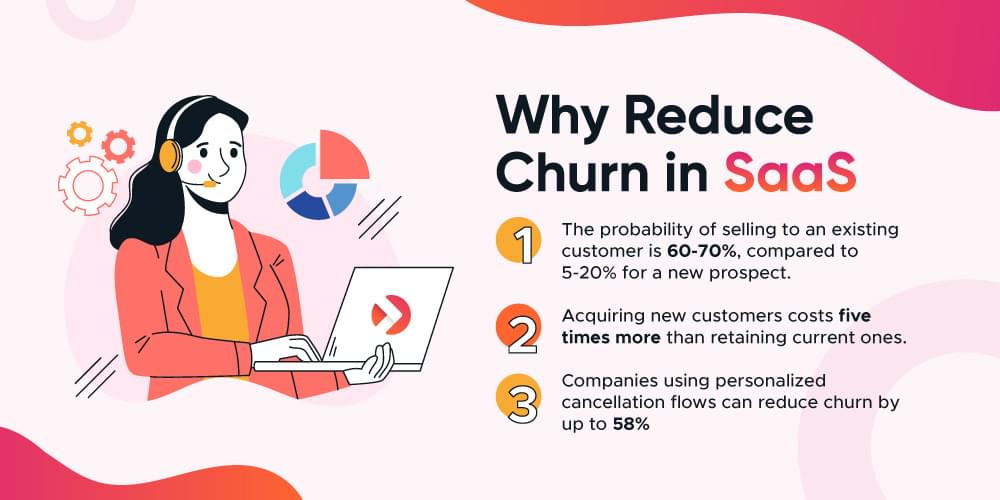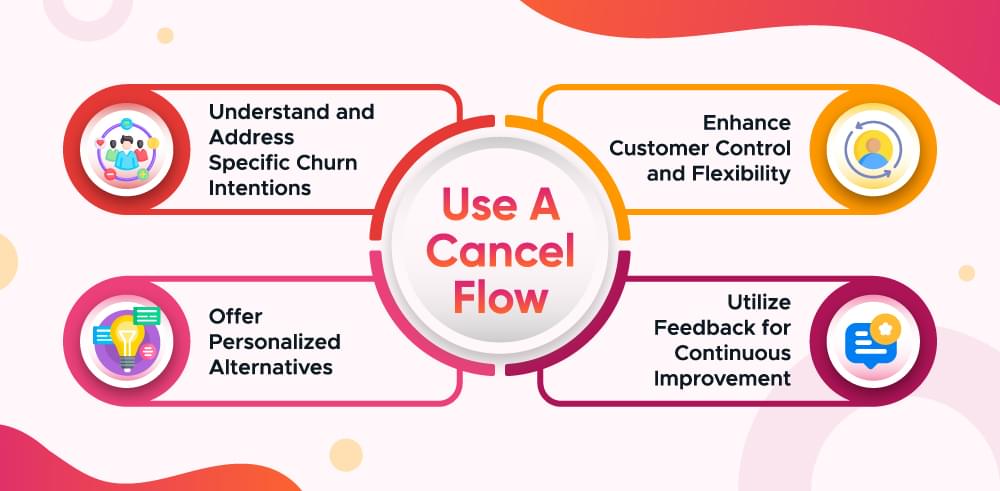
Reduce Churn SaaS in 2024. Methods that actually work!

To reduce churn in a SaaS company, you must focus on customer satisfaction. Customer satisfaction can be gained in many ways other than improving product services for SaaS, where their subscription services are billed monthly and usually need to achieve churn rate benchmarks.
Table of Contents
The SaaS churn rate is very common in the industry because of the competitive market. The average churn rate for subscription services (MRR) is 3% to 7%.
Related Read: What is a good churn rate for SaaS?
Achieving an ideal SaaS churn rate is not that hard. Many SaaS companies succeed in getting a good net negative churn by the end of the year. Below are some reduce churn SaaS strategies that will help you reduce churn SaaS.
Before we learn more about reducing SaaS churn, let’s see three reasons you should reduce churn in SaaS.
Why is Reducing SaaS Churn Important?
Churn is often an indicator of customer dissatisfaction or disengagement. Addressing churn requires understanding the underlying reasons and taking proactive steps to improve customer satisfaction.
High churn rates directly impact a company’s revenue and financial performance by reducing recurring revenue, hindering profitability, and increasing customer acquisition costs. Thus, reducing churn becomes a top priority, as retaining existing customers is more cost-effective than acquiring new ones.
It also has a lasting impact on a business’s revenue, profitability, and customer relationships. Studies suggest that a 5% reduction in churn rate can increase a company’s profitability by up to 95% over five years.

Now, let’s dig into some effective methods to reduce churn in 2024.
How to Reduce Churn in SaaS
Below are some strategies to reduce churn in SaaS. Implement these in your churn reduction strategy to boost revenue and achieve a net negative churn rate.
1. Use a Cancel Flow
Implementing a strategic cancel flow is critical in reducing customer churn and retaining customers within your SaaS business. By understanding and addressing the reasons behind a customer’s decision to cancel, you can prevent churn and improve your service’s overall quality and customer satisfaction.
Understand and Address Specific Churn Intentions
A robust cancellation flow starts by identifying why customers are considering cancellation. During the cancellation process, use an exit survey to gather insights. Keep these surveys short—limiting them to a few essential questions—to ensure higher completion rates. This data will help you understand common issues and tailor your retention strategies more effectively.
Offer Personalized Alternatives
Upon identifying the reasons for cancellation, present personalized offers that directly address the customer’s concerns. For instance, consider offering a discount or a different pricing tier if the cost is a concern. If the customer feels the product lacks value, showcase features or services they might have overlooked. This approach demonstrates your commitment to their satisfaction and reduces the likelihood of cancellation.
Enhance Customer Control and Flexibility
Ensure that your cancellation flow empowers customers with options. Giving them control over their subscription decisions increases their trust and satisfaction. Allow them to easily pause subscriptions or switch between different service tiers per their current needs. This flexibility can significantly deter customers from leaving and instead maintain a relationship with your service.
Utilize Feedback for Continuous Improvement
The feedback collected through cancellation flows should be a goldmine for continuous product and service improvement. Analyze the feedback to identify trends and recurring issues. Address these in your product roadmap to meet customer expectations better and enhance their overall experience.
Consider using tools like Churnfree to build customizable retention cancellation flows with your customized offers. By strategically enhancing your cancellation flow, you can reduce churn and turn potentially negative customer experiences into positive ones, fostering loyalty and winning back customers even after they’ve decided to leave.

2. Use Customer Feedback Analytically
Use the feedback of customers analytically. You can use churn management software to segment the user’s feedback and analyze the data. Tools like Churnfree will give you a detailed analysis of why customers left via their analytics dashboard.
You can then use the customer feedback to improve your product, customer service, or pricing and win back customers. You can use the feedback from users to not only improve your product but also offer discounts, solve their queries, or give them a product demo.
You can also analyze the feedback to identify trends and recurring issues. Address these in your product roadmap to meet customer expectations better and enhance their overall experience.
3. Proactive Customer Success Initiatives
For SaaS churn management, you must also focus on streamlining customer success. This lets you track customer interactions, usage patterns, and real-time feedback.
Create Personalized Customer Success Plans
Develop a structured plan for each customer segment that clearly outlines the steps needed to achieve their goals with your product. Regularly review and update these plans to reflect any changes in the customer’s objectives or usage patterns. This personalized approach ensures that each customer receives attention tailored to their specific needs, increasing their likelihood of success and continued engagement with your service.
Continuous Monitoring and Support for Customer Utilization
Regular check-ins are essential to understanding how customers are using your product and providing them with timely guidance. Schedule these sessions to discuss their progress, address any challenges they might be facing, and offer personalized advice. Additionally, customer data must be monitored to track usage and satisfaction levels. This continuous support and monitoring reinforce your commitment to their success and can significantly reduce the likelihood of churn.
4. Bring Flexibility in your Pricing Plans
To reduce churn in SaaS and enhance customer satisfaction, you should adopt smart payment methods. Establish clear and predictable billing to avoid surprising customers with unexpected charges. Offering prorated charges for changes in subscription levels makes customers comfortable on the pricing package they are buying. You can offer flexible subscription models such as tiered pricing with 3 to 4 levels for customers to choose the best for their needs. Moreover, You can also create a custom pricing calculator for your customers to make them confident about billing.
5. Strengthening Onboarding Processes
A well-structured onboarding process is crucial for ensuring that your customers quickly see the value in your SaaS product. Creating a step-by-step program that guides new users through the essential features and functionalities sets the stage for a successful user experience. This structured approach helps reduce the common reasons for churn. Ensure to include interactive elements such as guided tours or interactive tutorials, which can help users feel more engaged and confident in navigating your software.
Providing Hands-on Support During the Initial Setup
During the early stages of onboarding, it’s vital to offer hands-on support to your customers. Assign a dedicated onboarding specialist or support team to guide new users through the setup process. This direct interaction not only helps in resolving any immediate queries but also demonstrates your commitment to their success. A smooth initial setup experience can significantly enhance customer satisfaction and reduce the likelihood of early churn.
Ensuring Customers Understand and Derive Value from the Product Immediately
From the beginning, your onboarding process should focus on demonstrating the value your product brings. Communicate how each feature addresses the customer’s needs and contributes to their business goals. Establish early milestones and celebrate when customers achieve them, reinforcing the benefits they’re gaining. Additionally, incorporating regular feedback loops during this phase can help you gather insights and make necessary adjustments to improve the onboarding experience continuously.
6. Engaging Customers Through Personalized Communication
Engaging with your customers personally can significantly enhance their loyalty and overall satisfaction. Customize your communication strategies using targeted guides, tutorials, and a well-curated FAQ or help center that addresses specific user groups. Personalized email responses and offering early access to new features to loyal customers can make them feel valued and part of your product’s evolution.
Additionally, leveraging multiple channels to collect feedback—be it through direct comments, social media interactions, or indirect methods like tracking and heat maps—enables you to gather comprehensive metrics. These insights help in making data-driven decisions that more effectively cater to user needs, from fixing bugs to enhancing marketing strategies.
By implementing these strategies, you not only gather valuable feedback but also use it to forge stronger relationships with your customers, making them more likely to stay with your service and less likely to churn.
7. Continuous Product Improvement and Innovation
Focusing on customer-driven product development is essential to staying relevant and competitive in the fast-paced SaaS market. By keeping customers in loop, you can make sure that your product meets their changing needs. This can be achieved through various methods, such as feedback surveys, beta testing of new features, and establishing customer advisory boards. When customers feel they have a voice in the product’s evolution, their engagement and satisfaction levels will likely increase, fostering a deeper connection with your service.
Introducing new features, improvements, and updates is crucial to keep the product fresh and aligned with customer expectations. This awareness will guide your decisions on which innovations and updates to implement, ensuring that your product remains at the forefront of the industry.
Another pivotal strategy is utilizing customer feedback for product enhancements and new features. Customer feedback provides invaluable insights into how your product is used and perceived in the real world. By collecting and analyzing feedback, you can identify areas that need improvement and opportunities for new features that address user pain points. Implementing a feedback loop mechanism allows for continuous collection and analysis of customer opinions, enabling quick adaptations to your product that align with customer desires and market changes.
Integrating these strategies into your product development process can enhance customer satisfaction, reduce churn, and maintain a competitive edge in the SaaS industry.
If you want to learn more about how to reduce churn, follow the Churnfree blog.
FAQs
How Can SaaS Companies Reduce Their Churn Rate?
To lower the churn rate in SaaS, monitoring customer engagement closely is crucial. A decline in engagement can signal impending churn, allowing companies to take proactive measures. Strategies include sending reactivation emails, offering discounts, providing special offers like unlocking features at no cost, or adding new users to re-engage customers.
What Are the Top Strategies for Minimizing Customer Attrition and Boosting Retention?
The key customer retention strategies and enhancing retention involve embedding retention mechanisms within your product, maintaining personal connections with customers, identifying customers at risk of leaving through NPS surveys, and motivating customers to opt for annual contracts whenever feasible.
How Can Customer Success Representatives Help in Reducing Churn?
Customer success representatives can play a significant role in churn reduction by employing a variety of strategies. These include analyzing the reasons behind churn, engaging with customers, educating them about the product, identifying which customers are at risk, pinpointing the most valuable customers, offering incentives, targeting the appropriate audience, and providing superior customer service.


